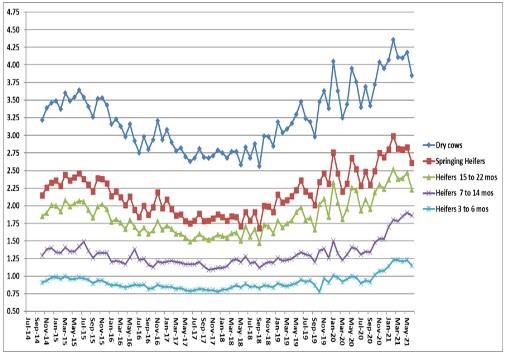Corn silage is commonly fed in rations for lactating cows and is complemented with a grass, legume, or mixture. Depending on the current forage inventory, and with first cut hay-crop harvest completed, rations may contain greater amounts of small grain silage or haylage during July and August. The first step is to analyze forages for their fiber content.
Acid detergent fiber (ADF) contains cellulose and lignin. Neutral detergent fiber (NDF) is ADF plus hemicellulose. The proportion and total amounts of these plant cell wall components can vary dramatically between grasses and legumes at similar maturities. Generally, in grass forages, ADF will be 60-65% of the NDF. For legumes, because of the high lignin content, ADF can be more than three quarters of the NDF (Table 1). This can be helpful when identifying legume grass mixes and determining which forage comprises most of the mixture. This is useful information for understanding why problems may be occurring with dry matter intake or cow performance.?
There is more to fiber than the value alone. The NDF digestibility of forages is an important aspect related to milk production, dry matter intake and feed efficiency.? Fiber digestibility is usually defined as the proportion of consumed fiber that is NOT excreted in the feces. ?Fiber contains an indigestible fraction like lignin and one or more potentially digestible fractions, each of which is degraded or digested at its own rate. ?The extent of fiber digestion depends on the size of the indigestible fraction and the competition between the rates of degradation and passage out of the rumen. ?
Grasses have more digestible fiber compared to legumes and are more filling to the cow. This results in a slow passage rate out of the rumen.? Legumes have more indigestible fiber and are less filling. This results in a faster rate of passage through the rumen and allows for more dry matter intake. ?
There are some practical feeding strategies to consider related to forage NDF for early and late lactation cows. ?Assume a rumen retention time for forage NDF of 30 hours for early lactation cows. ?The potential digestible NDF fraction of alfalfa may be almost completely digested in the rumen while that of grass is not. ?At shorter ruminal retention times, legume forages may have greater dry matter digestibility because of their lower NDF content.? Dry matter intake in early lactation cows is usually limited by physical fill. Offering fiber sources, such as alfalfa, which digest and pass from the rumen more quickly may increase energy intake. ?
For late lactation cows, let's assume a rumen retention time for NDF of 48 hours. Grass forages may have greater NDF digestibility when fed to cows with longer ruminal retention times. Mid to late lactation cows, because of their longer ruminal retention times, can utilize grass forages which may ferment more slowly, but have a higher potential digestibility.?
If the opportunity exists to feed milk cows differently based on their stage of lactation and if legume and grass forages are a part of the feed inventory, then strategizing the rations during the summer could offset reduced intakes. Optimizing milk volume and components during the summer months can positively affect the milk price and ultimately milk income.
Table 1. Identifying legume and grass mixtures using ADF and NDF.
| | Mixed mainly legume silage
% dry matter basis | Mixed mainly grass silage
% dry matter basis |
|---|
| Acid detergent fiber | 34.9 | 36.8 |
| Neutral detergent fiber | 47.2 | 55.5 |
| Confirm mixture is correct | ADF is 73.9% of NDF | ADF is 66.3% of NDF |
Economic perspective:
Monitoring must include an economic component to determine if a management strategy is working or not. For the lactating cows, income over feed cost is a good way to check that feed costs are in line with the level of milk production. Starting with July 2014’s milk price, income over feed cost was calculated using average intake and production for the last six years from the Penn State dairy herd. The ration contained 63% forage consisting of corn silage, haylage, and hay. The concentrate portion included corn grain, candy meal, sugar, canola meal, roasted soybeans, Optigen, and a mineral vitamin mix. All market prices were used.
Also included are the feed costs for dry cows, springing heifers, pregnant heifers, and growing heifers. The rations reflect what has been fed to these animal groups at the Penn State dairy herd. All market prices were used.
Income over feed cost using standardized rations and production data from the Penn State dairy herd.

Note: June’s Penn State milk price: $19.64/cwt; feed cost/cow: $7.72; average milk production: 83 lbs.
Feed cost/non-lactating animal/day.

Source : psu.edu